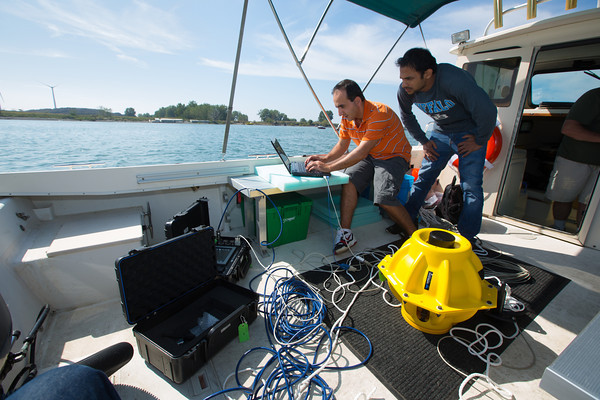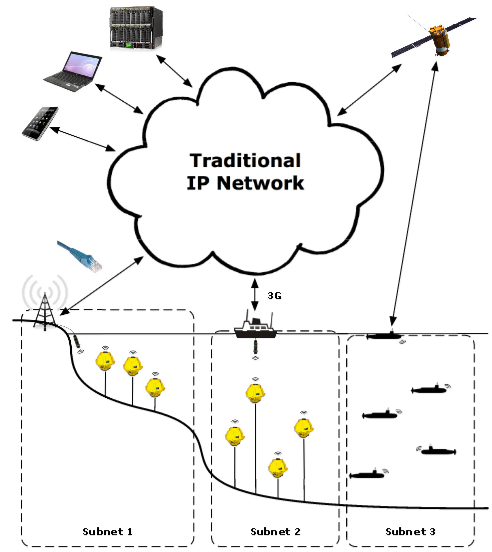Creating a deep-sea Internet
October 17, 2013

Electrical
Engineering Graduate Students Hovannes Kulhandjian and Zahed Hossain in
the lab (boat) of Tommaso Melodia’s WINES Lab Research on Lake Erie
(credit: Douglas Levere)
“A submerged wireless network will give us an unprecedented ability to collect and analyze data from our oceans in real time,” said Tommaso Melodia, UB associate professor of electrical engineering and the project’s lead researcher.
“Making this information available to anyone with a smartphone or computer, especially when a tsunami or other type of disaster occurs, could help save lives.”
Radio waves work poorly underwater. This is why agencies like the Navy and National Oceanic and Atmospheric Administration use sound wave-based techniques to communicate underwater.
For example, NOAA relies on acoustic waves to send data from tsunami sensors on the sea floor to surface buoys. The buoys convert the acoustic waves into radio waves to send the data to a satellite, which then redirects the radio waves back to land-based computers.
Creating the deep-sea Internet
[+]
Many systems worldwide employ this paradigm, says Melodia, but
sharing data between them is difficult because each system often has a
different infrastructure.
Deep-sea Internet system architecture (credit: Yifan Sun and Tommaso Melodia)
The framework Melodia is developing would solve that problem. It would transmit data from existing and planned underwater sensor networks to laptops, smartphones and other wireless devices in real time, and enables support for a traditional TCP/IP protocol stack.
Melodia tested the system recently in Lake Erie, a few miles south of downtown Buffalo. Hovannes Kulhandjian and Zahed Hossain, who are both doctoral candidates in his lab, dropped two, 40-pound sensors into the water.
Kulhandjian typed a command into a laptop. Seconds later, a series of high-pitched chirps ricocheted off a nearby concrete wall, an indication that the test worked.
Funded by the National Science Foundation, the team, which includes 15 associates at UB, carries out research in wireless communications and networking, cognitive radios, extreme environment (underwater, underground) communications, secure communications, data hiding, information theory and coding, adaptive signal processing, compressed sensing, multimedia systems, magnetic resonance imaging and radar systems.
Applications
A deep-sea Internet has many applications, including linking together buoy networks that detect tsunamis. In these situations, it could deliver a more reliable warning thereby increasing the odds that coastal residents can evacuate, Melodia said.
It may also help collect oceanographic data and monitoring pollution. The framework will encourage collaboration among researchers and, potentially, eliminate the duplicative deployments of sensors and other equipment, he said.
There are also military and law enforcement applications. For example, drug smugglers recently have deployed makeshift submarines to clandestinely ferry narcotics long distances underwater. An improved, more robust underwater sensor network could help spot these vessels.
The framework could also be useful to the energy industry, which typically relies on seismic waves to search for underwater oil and natural gas. Industry’s efforts could be aided by network of interconnected devices working together, he said.
“We could even use it to monitor fish and marine mammals, and find out how to best protect them from shipping traffic and other dangers,” Melodia said. “An Internet underwater has so many possibilities.”
Melodia and his students will present a paper, “The Internet Underwater: An IP-compatible Protocol Stack for Commercial Undersea Modems,” at the 8th annual International Conference on Underwater Networks & Systems. Hosted by the Association for Computing Machinery, the conference runs Nov. 11–13 in Taiwan.
Photos of the system in action are available here: http://smu.gs/164xGCB.
Abstract of International Conference on Underwater Networks & Systems paper
Recent underwater sensor network research has focused on developing physical, medium access control, and network layer protocols to enable high data rate, energy-efficient and reliable acoustic communications. However, it is now essential to design and standardize architectures that will enhance the usability and interoperability of underwater networks. This paper proposes a networking architecture to efficiently provide interoperability with traditional TCP/IP protocol stacks for commercial underwater modems. The proposal is based on an adaptation layer located between the data link layer and the network layer, such that the original TCP/IP network and transport layers are preserved unaltered to the maximum extent. The adaptation layer performs header compression and data fragmentation to guarantee energy efficiency. Furthermore, the proposed architecture includes mechanisms for auto-configuration based on router proxies that can avoid human-in-the-loop and save energy when broadcast is needed. The proposed architectural framework was implemented as a Linux device driver for a commercial underwater network modem SM-75 by Teledyne Benthos. Testing and simulation results illustrate that the ar- chitecture efficiently provides interoperability with TCP/IP.
(¯`*• Global Source and/or more resources at http://goo.gl/zvSV7 │ www.Future-Observatory.blogspot.com and on LinkeIn Group's "Becoming Aware of the Futures" at http://goo.gl/8qKBbK │ @SciCzar │ Point of Contact: www.linkedin.com/in/AndresAgostini
 Washington
Washington